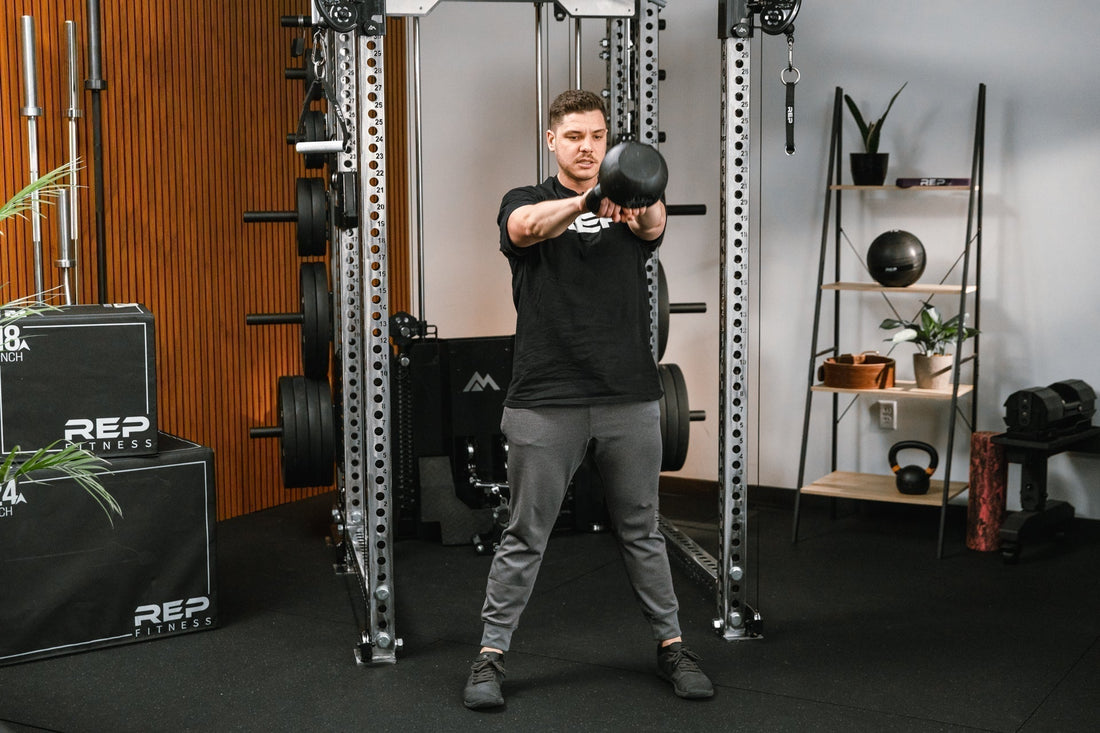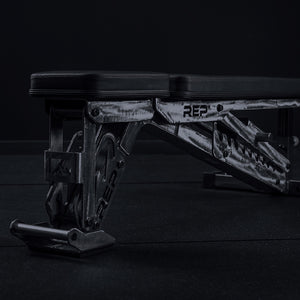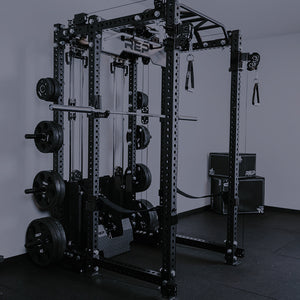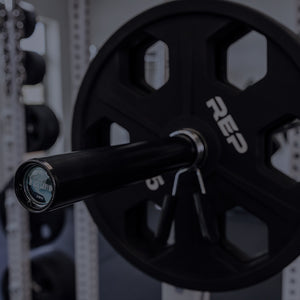
Glutes. Grip. Grit.
Kettlebell swings are a dynamic full-body movement that build strength, power and endurance. Learn how to do kettlebell swings with proper form, what muscles they work, key variations and tips to level up your training.
What are kettlebell swings?
The kettlebell swing is a dynamic, full-body movement that does it all. It works just about every muscle group, building explosive power and strength—and it’s a killer exercise for training endurance.
CrossFitters, casual lifters and home-gym heroes alike practice kettlebell swings for cardio and serious posterior-chain power.
Let’s talk about how to perfect your technique.
How to do kettlebell swings with proper form
Kettlebell swings are deceptively simple, but you have to do them with proper form to get those massive payoffs. Let’s break it down:
Start with the setup. While standing, place the kettlebell about a foot in front of you. Feet slightly wider than shoulder width. Hinge at your hips, slightly bend your knees and grip the handle with both hands. Hold tight!
Hike the kettlebell. Keeping your spine neutral and your core engaged, swing the bell back between your legs like you're snapping a football.
Explode with the hips. Drive through your glutes and hamstrings to swing the bell forward and up. This is where the power comes from. Let the ball float to chest height (for Russian kettlebell swings) or overhead (for American kettlebell swings).
Stand tall. At the top of the swing, lock your hips and squeeze that core. Don’t resist the backswing.
Let the kettlebell fall. Guide the bell back down, hinge again and repeat. Keep your arms relaxed but that grip firm (you do NOT want to send a kettlebell flying across the room).
Remember, this is a hip driven movement. You’re working with gravity to find a rhythm.
According to Monica Henrichs, CPT & PPSC Kettlebell specialist, that hip-hinge is essential: “If someone can’t get their hips back or they’re squatting too much, they won’t be able to get the rhythm.”
What muscles do kettlebell swings work?
Primary Muscles:
- Gluteus maximus
- Hamstrings
- Erector spinae
- Latissimus dorsi
Secondary Muscles:
- Core (rectus abdominis, obliques)
- Forearms and grip
- Deltoids (particularly in American swings)
- Hip adductors
They work pretty much everything—and strength is just one of many kettlebell swing advantages. They’re also great for conditioning and improving grip strength.

Types of kettlebell swings
There’s more than one way to swing. As Henrichs says, “The variations are only limited by your imagination!” If you’ve ever doomscrolled through FitTok, you know what she means. But we’ll give you some ideas.
- Russian Kettlebell Swing. The classic. Swing the bell to chest height.
- American Kettlebell Swing. Swing the bell overhead for more shoulder and core involvement. CrossFitters love this one.
- Single Arm Swing. Make the swing a unilateral movement with one hand—great for stabilizing your core and strengthening grip.
- Reset Swing. After each rep, re-set the bell at its starting position. Less cardio-intensive, but more form focus.
- Banded Swing. Want more? Wrap a resistance band under your feet and around the handle for more tension at the top.
- Kettlebell Swing to Goblet Squat. You still want more? Combine a swing with a goblet squat to really feel the burn.
- Lateral Kettlebell Swing. This is a kettlebell swing alternative that’s a bit more advanced, so be safe. From the same start position, swing the bell side-to-side.
Common kettlebell swing mistakes
- Letting the bell drop too low. Swinging the bell too far down can pull your back out of alignment. “Get the kettlebell higher towards the center of “the triangle”…higher up towards the inner thighs,” Henrichs says.
- Squatting instead of hinging. Don’t bend those knees too much. Your shins should stay mostly vertical, and your butt should be pushed back—not down.
- Rounding the back. Keep that spine neutral and that chest proud! Otherwise, you’re asking for back pain. Avoid the ice pack by making sure your core is engaged.
- Using shoulders to lift the kettlebell. Don’t muscle the bell up with your shoulders or arms. Henrichs tells REP, “the swing is a constant motion and your glutes are actually lifting the kettlebell up.”
How to choose the right kettlebell type, size and weight

There are tons of kettlebells out there (literally).
Cast Iron Kettlebells are the most popular. REP’s kettlebells are gravity die-cast for precise weight and a perfectly flat base. The textured, premium black coating makes for a solid grip. Choose between 5lb-50lb or 1kg-48kg.
Worried about clutter? REP's Adjustable Kettlebells are the way to go. They come in three different sizes, each with their own range of weights.
Most newbies start with 10-15 lbs (or approx. 4-6 kg) for their first swing. Take it from Heinrichs: “Start light! Learn the technique…when the mechanics are there, grab that heavier bell!”
Even if swings aren’t your thing, you should train with kettlebells.
Takeaway
Kettlebell swings are a simple but savage movement to build power, conditioning and strengthen the posterior chain. They hit a buttload muscle groups, especially the butt. Whatever your goals, swings deserve a spot in your next routine or workout.
FAQs
Why should I do kettlebell swings?
Because they’re fun! But seriously, they are a high-intensity, low-impact exercise that help you generate explosive power while also improving cardiovascular fitness. You can also do them anywhere, even outside.
What if kettlebell swings make my back hurt?
Focus on that hip hinge. The power comes from that thrust. Your core should be braced to keep that back flat. If you’re still feeling it, scale back the weight and check your form.
How often should I do kettlebell swings?
“You could truly do kettlebell swings every day,” Henrichs says. So long as you’re allowing for recovery. If you’re new to swings, start with 2-3 days a week. Once you get comfortable, add another day. Generally, trainers aim for 3-4 days per week with different intentions.
How many kettlebell swings should I do?
Depends on your goal. For conditioning, try swing intervals for 30 seconds on, 30 seconds rest for 10-15 minutes. For strength, go heavier and perform 3-5 sets of 10-15 reps. If you want to get spicy, try kettlebell swing ladders: Perform 1 rep. Rest for 1 breath. Then 2 reps. Rest for 1 breath. 3 reps, 1 breath—and so on until 20 reps. Buckle up for that one.
Dennis Dorrell is a writer, editor, and lifelong fitness enthusiast. If he’s not being scolded for dropping weights too loudly in the gym, he’s probably on top of some mountain trying to get his dog to sit still for a photo.
This article was reviewed by Ashley Boyer, ACE-CPT, for accuracy.
similar to this

NEWSLETTER SIGNUP
Product launch information, promotions, blogs, and REP news.







